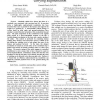Free Online Productivity Tools
i2Speak
i2Symbol
i2OCR
iTex2Img
iWeb2Print
iWeb2Shot
i2Type
iPdf2Split
iPdf2Merge
i2Bopomofo
i2Arabic
i2Style
i2Image
i2PDF
iLatex2Rtf
Sci2ools
IROS
2006
IEEE
2006
IEEE
An autonomous, underactuated exoskeleton for load-carrying augmentation
- Metabolic studies have shown that there is a metabolic cost associated with carrying load [1]. In previous work, a lightweight, underactuated exoskeleton has been described that runs in parallel to the human and supports the weight of a payload [2]. A state-machine control strategy is written based on joint angle and ground-exoskeleton force sensing to control the joint actuation at this exoskeleton hip and knee. The joint components of the exoskeleton in the sagittal plane consist of a force-controllable actuator at the hip, a variable-damper mechanism at the knee and a passive spring at the ankle. The control is motivated by examining human walking data. Positive, non-conservative power is added at the hip during the walking cycle to help propel the mass of the human and payload forward. At the knee, the damper mechanism is turned on at heel strike as the exoskeleton leg is loaded and turned off during terminal stance to allow knee flexion. The passive spring at the ankle engages i...
| Added | 12 Jun 2010 |
| Updated | 12 Jun 2010 |
| Type | Conference |
| Year | 2006 |
| Where | IROS |
| Authors | Conor James Walsh, Kenneth Pasch, Hugh M. Herr |
Comments (0)

